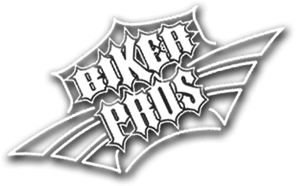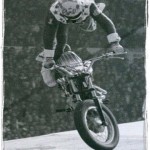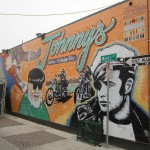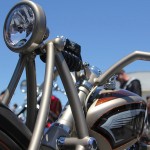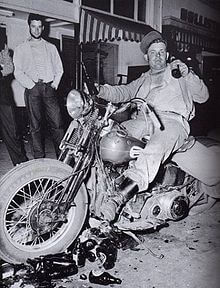
Bikers Flying the Freak Flag
The Hollister riot was an event that occurred at the American Motorcyclist Association (AMA) sanctioned Gypsy Tour motorcycle rally in Hollister, California from July 3-6, 1947.
Many more motorcyclists than expected flooded the small town to watch the annual rallies as well as to socialize and drink. A very few of the motorcyclists got out of control and caused a commotion in the town, although at the end of the event, the damage was considered minor.
The small incident, known afterwards as the Hollister riot, was sensationalized by the press with reports of bikers “taking over the town” and “pandemonium” in Hollister. The strongest dramatization of the event was a staged photo of a drunken man sitting on a motorcycle surrounded by beer bottles. It was published in Life magazine and it brought national attention and negative opinion to the event. The Hollister riot helped to give rise to the outlaw biker image.
Hollister Rally In The News
A short story, Cyclists’ Raid, by Frank Rooney is based on the events of the Hollister riot and was originally published in the January 1951 issue of Harper’s Magazine. This story made up the basis of the plot of the 1953 film, The Wild One, starring Marlon Brando. However, as a dramatized version, it bears little resemblance to the actual events of the Hollister riot. The movie only worked to further bring the riot into public light and with motorcyclists portrayed as misfits and outlaws, it eliminated any way to salvage motorcycling’s already tarnished image.
Rise of motorcycles after World War II
After World War II, countless veterans came back to America and many of them had a difficult time readjusting to civilian life. They searched for the adventure and adrenaline rush associated with life at war that had now left them. Civilian life felt too monotonous for some men who also craved feelings of excitement and danger. Others sought the close bonds and camaraderie found between men in the army. Furthermore, certain men wanted to combat their horrifying war memories and experiences that haunted them, many in the form of Post Traumatic Stress Disorder. Thus, motorcycling emerged stronger than ever as a substitute for wartime experiences such as adventure, excitement, danger and camaraderie. Men who had been a part of the motorcycling world before the war were now joined by thousands of new members. The popularity of motorcycling grew dramatically after World War II because of the effects of the war on veterans.
Throughout the 1930s, Hollister, California hosted an annual Fourth of July gypsy tour event. Gypsy tours were American Motorcyclist Association sanctioned racing events that took place all over America and were considered to be the best place for motorcyclists to converge. The annual event consisted of motorcycle races, social activities, and lots of partying. In Hollister, the event and the motorcyclists were very welcome. Especially because Hollister was a very small town, with only about 4,500 people, the rally became a major event in its yearly life as well as an important part of the town’s economy. Due to World War II, the rally was canceled, but the event organized for 1947 was the revival of the Gypsy Tour in Hollister.
On July 3, 1947, the festivities in Hollister began. But as previously mentioned, the popularity of motorcycles grew dramatically and this rise in popularity caused one of the main problems of this event: massive attendance. Around 4,000 motorcyclists flooded Hollister, almost doubling the population of the small town. They came from all over California and the United States, even from as far away as Connecticut and Florida. Motorcycle groups in attendance included the Pissed Off Bastards of Bloomington, the Boozefighters, the Market Street Commandos and the Galloping Goose Motorcycle Club. Approximately ten percent of attendees were women. The town was completely unprepared for the number of people that arrived. The large attendance was unexpected since not nearly as many people had come in previous years.
Initially, the motorcyclists were welcomed into the Hollister bars, as the influx of people was great for business. But soon, they started causing a problem in Hollister. The drunken motorcyclists were riding their bikes through the small streets of Hollister and consuming huge amounts of alcohol. They were fighting, damaging bars, throwing beer bottles out of windows, racing in the streets, and other drunken actions. Also, there was a severe housing problem. The bikers had to sleep on sidewalks, in parks, in haystacks and on people’s lawns. By the evening of July 4th, “they were virtually out of control”.
This was all too much for the seven-man police force of Hollister to handle. The police tried to stop the motorcyclists’ activities by threatening to use tear gas and by arresting as many drunken men as they could. Also, the bars tried in vain to stop the men from drinking by refusing to sell beer and voluntarily closing two hours ahead of time.
Eyewitnesses were quoted as saying, “It’s just one hell of a mess”, but the motorcyclists weren’t doing anything bad, just riding up and down whooping and hollering; not really doing any harm at all.”
The ruckus continued through July 5th and slowly died out at the end of the weekend as the rallies ended and the motorcyclists left town.
At the end of the Fourth of July weekend and the informal riot, Hollister was littered with thousands of beer bottles and other debris and there was some minor storefront damage. About 50 people were arrested, most with misdemeanors such as public intoxication, reckless driving, and disturbing the peace. There were around 60 reported injuries, of which 3 were serious, including a broken leg and skull fracture. Other than having to witness the chaos of the weekend, no Hollister residents suffered any harm at all. A City-Council member stated, “Luckily, there appears to be no serious damage. These trick riders did more harm to themselves than the town.”

